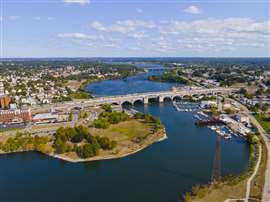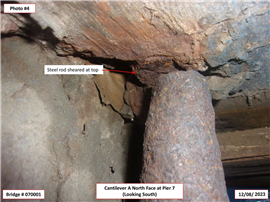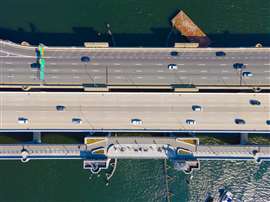US State of Rhode Island suing 13 companies over bridge closure
23 August 2024
In a complaint filed on 16 August in the US State of Rhode Island’s Providence/Bristol County Superior Court, the state is accusing 13 design, construction, inspection and contracting companies of failing to identify structural issues on the Washington Bridge before it was forced into a sudden closure in December 2023.
 Rhode Island authorities received zero bids for a US$78 million project to rebuild the Washington Bridge in Providence. The structure is set to be demolished as Rhode Island sues 13 companies associated with its construction and maintenance. (Image: Adobe Stock/Wangkun Jia)
Rhode Island authorities received zero bids for a US$78 million project to rebuild the Washington Bridge in Providence. The structure is set to be demolished as Rhode Island sues 13 companies associated with its construction and maintenance. (Image: Adobe Stock/Wangkun Jia)
The 13 firms (Defendants) all performed work on the bridge in the last ten years, according to the state. In filing the complaint, Rhode Island is seeking financial retribution for any costs associated with the closure, including rerouting of traffic.
The state alleged the group, over one decade of work and inspection on the bridge, failed to recognise and report the structure’s flagging condition.
“The Defendants… all knew or should have known of the engineering features of the bridge, and therefore should have taken these characteristics into account as part of their collective obligations,” stated the complaint.
The state and RIDOT (Plaintiffs) said the bridge will need to be demolished, redesigned, and rebuilt, which it said will cost “hundreds of millions of dollars.”
The Washington Bridge was closed suddenly in late 2023 after a contracted engineer discovered a failure in one of the bridge’s tie rods. A subsequent state inspection days later revealed more flaws, which prompted the immediate closure of the bridge to traffic.
The 13 US-based firms listed as Defendants, in alphabetical order, are: Aecom Technical Services, Aetna Bridge Company, Aries Support Services, Barletta Heavy Division, a job-specific Barletta/Aetna JV, Collins Engineers, Commonwealth Engineers & Consultants, Jacobs Engineering Group, Michael Baker International, Prime AE Goup, Steere Engineering, Transystems Corporation and Vanasse Hangen Brustlin.
Why did the Washington Bridge close so suddenly?
 Failing structural elements on Rhode Island’s Washington Bridge. (Image courtesy RIDOT)
Failing structural elements on Rhode Island’s Washington Bridge. (Image courtesy RIDOT)
The complaint stated the closure was the result of fractured steel tie-down rods, which were “critical to the stability of the bridge”.
“Subsequent investigation revealed even more serious problems, including extensive deterioration in the post-tensioning system in cantilever beams used throughout the bridge,” stated the complaint. “The severe and pervasive nature of these problems has rendered the Washington Bridge unsalvageable.”
Both balanced and unbalanced general configurations were used on the bridge, which the Plaintiff referred to as “most unusual, if not unique” and suggested it was one-of-a-kind in the country and potentially all the world.
The beams run through 18 spans of various structural types. In the balanced cantilever configuration, stability of the beam is established by the weight of adjacent drop-in prestressed girder spans and vertical rods, which anchor the cantilever beam to a supporting pier. The unbalanced segments use a drop-in prestressed girder span on just one end of the cantilever, and stability is maintained by tie-down rods on the opposite end of the beam from the drop-in span.
“In addition to using tie-down rods, the original design also incorporated another critical feature: the use of post-tensioned cables in concrete beams used throughout the bridge,” added the complaint. “The post-tensioned cables were sued to construct post-tensioned concrete beams, which – when working properly – provided stability to the bridge and prevented the beams from cracking when carrying live traffic loads.”
Distress, cracks, and corrosion over the years compromised individual parts of the bridge, which “can severely compromise the integrity of the prestressed, post-tensioned concrete beams.”
Timeline of the Washington Bridge closure
 Aerial view of Washington Bridge between City of Providence and East Providence on Seekonk River in Rhode Island, US. (Image: Adobe Stock)
Aerial view of Washington Bridge between City of Providence and East Providence on Seekonk River in Rhode Island, US. (Image: Adobe Stock)
The Washington Bridge serves as a motorway connection over the Seekonk River in Rhode Island, connecting the state’s capital city of Providence with East Providence.
It was designed in the 1960s by Charle A. Maquire & Associates and constructed by Rhode Island-based Aetna Bridge, which delivered the project in 1968.
A report in the 1990s led to one rehabilitation effort, but another inspection in 2011 found the superstructure in “poor” condition.
By 2014, the state had developed a design-build plan for repairs of Washington Bridge and contracted with Aecom for design services. Aecom brought in subcontractors Steere, Prime AE and Aries Support Services.
Aecom submitted to RIDOT a technical evaluation and inspection report in early 2015 and transmitted its final construction plans and specifications in September 2016.
“The 2016 construction plans failed to identify, analyse, or recommend improvements ‘necessary to completely rehabilitate the existing structure’ as required by the 2014 Aecom contract,” said the complaint.
One year later, a contract with Cardi Corporation to rehabilitate the bridge was terminated after delays to construction work relating to traffic management (for which Rhode Island said Aecom was responsible). Cardi Construction shuttered in 2023 and its assets were sold in early 2024.
About one dozen more inspections were conducted from 2015 to 2023, with several of the listed Defendants performing the work.
On 11 December last year, the Rhode Island Department of Transportation (RIDOT) issued an Emergency Declaration to close the bridge citing a need to protect public safety and “prevent catastrophic injuries to persons or property.”
Next steps, including potential hearing or court dates, were not yet available.
CONNECT WITH THE TEAM





